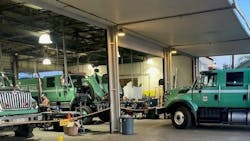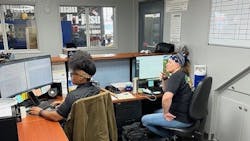How a California shop balances versatility with standardization
When Jennifer Wilson and her husband, Steve, struck out to start their own shop in Colton, California, in 2019, both knew the endeavor wouldn’t be easy. But with both having served in many fleet-focused roles already (she as a driver, dispatcher, firefighter, and terminal manager and he as a transportation planner and west region fleet manager), the couple was ready to balance the flexibility, standardization, and accountability it takes to run an independent shop.
“Between the two of us, we pretty much determined that we're not going to let [the shop] fail,” Wilson remembered. “I can't go back to the real world and work for somebody else that just can't do it.”
This determination has helped the Wilsons grow Inland Empire Fleet Maintenance (IEFM), a truck repair and fleet maintenance provider, where variety is the rule of the day. After all, the total 9,000 sq.-ft. shop (6,000 sq. ft. of shop space plus 3,000 sq. ft. of office space and over an acre of parking) can service anything from light- to heavy-duty vehicles, including Fords and Freightliner M2s, Isuzu NPRs, and Hino 268s. And many of these vehicles come with their own software to let technicians diagnose each truck. To stay on top of all this activity, the couple works to teach their customers and technicians how to be nimble while keeping to standards and schedules, which helps the shop grow and keep their customers on the road.
Cultivating customers
For Wilson, a key step in helping maintain the flow of customers is by cultivating the kinds of clients the shop can count on. This process starts by monitoring data on those customers, with Wilson, the shop’s co-owner and operations manager, pulling reports from Fullbay that shows the kinds of services that they’re doing. As for how she uses this data, Wilson explained that she looks at which companies they work for that are the most profitable, and then she drills down to verify how these clients generate shop revenue whether they’re involved in IEFM’s maintenance program.
“Regular maintenance customers are the kind of customers that we're after,” Wilson stated. “We don't want to just do a repair for somebody every three months because they wait until stuff breaks down.”
Instead, she wants to cultivate customers that will bring in their equipment regularly, at least every 90 days, for inspections and preventative maintenance, because "It's difficult to offer a cost saving program to companies who wait till they break down to repair their trucks," she noted. And beyond cost savings, the vehicles' regular time in the shop helps both the shop and the driver, because it lets Wilson catch signs of wear.
Then she can warn the customer, “‘Hey, this is wearing out, or this is starting to show signs of wear,’” Wilson said. “'If this fails, it's going to cause you to be stuck on the side of the road. If we replace it now, then we're saving you the breakdown.’”
According to her, this can help a driver avoid a $10,000 one-time charge due to the combination of a roadside tow and an expensive repair, and instead spend $7,000 over a longer period of time. “Those $10,000 ‘one times’ turn into 40, 50 [thousand], easy,” Wilson said. While some fleets might already be aware of this maintenance math, some aren’t, which is why Wilson invests the time in reviewing her customer data that she does.
“We try to turn those non-thinking customers into those thinking customers,” she added.
Of course, to have a stable, consistent maintenance program, it helps to have technicians that do the program the same way every time. This is especially true if one technician starts a job, and another finishes it. This means that Wilson needs her technicians to have a similar understanding of processes and expectations, itself a balancing act with respecting a technician’s knowledge and experience.
“Obviously, some people are going to bring more to the table when it comes to figuring things out, and that's good, but you’ve gotta have a base ground about how everybody does everything,” Wilson noted. “That was something that took me a while to succumb to, was that you can't just let everybody do things their own way. You can let them have that experience, but at the same time, you have to have a baseline of how everybody does things.”
Equipping for versatility
While standardizing customer maintenance schedules and technicians’ best practices is all well and good, this doesn’t mean IEFM doesn’t still have to keep on its toes, given the many types of vehicles they see. This often means Wilson needs to carefully balance their equipment procurements and needs.
“My thing is, we tool up as we need to,” she said. As an example, “All trucks run on ECMs that are all managed by software. So having the best software for the job has been the most helpful in that aspect.”
IEFM uses Fullbay as its base writing software, as well as a Motor integration for labor and standard repair time guides. Additionally, they use Parts Cross to cross-reference part numbers for easier purchase. Additionally, IEFM also uses Mitchell 1 for repair guides, repair estimates, and wiring diagrams, partly for the company’s expertise and due to the clients they work with.
“We deal with leasing companies, and [Mitchell 1’s] what they live by,” Wilson commented.
But the shop also uses OEM software as well, such as Cummins Insight Pro, and Isuzu and Hino’s software, which helps them collect truck component data.
“Because the one thing about the Japanese truck manufacturers is we have all-encompassing software (multi-platform) software, and we use that to collect all data from all parts of the truck,” Wilson explained. But they also use Cummins because their products can come in any of the many vehicle types IEFM sees. With this software combination, Wilson noted that this lets the shop be as versatile as it needs to be.
“Having the combination of both for a shop that works on so many different models is what really helps,” Wilson stated, adding that the shop was planning to purchase some Ford software as well to handle tests that they can’t with their multi-platform systems.
To help keep down the costs of software purchases, Wilson said that she gauges whether the cost is worth it or not based on if the job they need the technology for will be repeated. For instance, she said that IEFM used to only see five or so Hinos a year, but now, the shop services five a month or five a week.
“The Hinos don’t talk to the other stuff very well, so because there is a need to have [their software], we invest in it,” Wilson concluded.
About the Author

Alex Keenan
Alex Keenan is an Associate Editor for Fleet Maintenance magazine. She has written on a variety of topics for the past several years and recently joined the transportation industry, reviewing content covering technician challenges and breaking industry news. She holds a bachelor's degree in English from Colorado State University in Fort Collins, Colorado.

